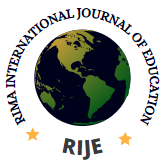Enhancing Relevance and Authenticity in STEM: Exploring Biomimecry in a Frog – Inspired Robot Designs in Developing Pre- School Children’s Manipulative Skills in STEM
Katniyon Henry David, Duguryil Zipporah Pewat, and Longmut Dakup Ibrahim
1,2&3Federal College of Education, Pankshin Plateau State, Nigeria, Nigeria
Abstract
This study explored biomimecry in a frog – inspired robot designs in developing pre- school children’s manipulative skills in STEM in Mangu Local Government Area, Plateau State, Nigeria. The research aims to assess the impact of manipulating robot components on children's motor skills and engagement, comparing the outcomes in experimental and control groups. The methodology involves constructing a frog robot using accessible materials and measuring children's skill acquisition in various tasks, such as gumming, fixing, and operating the robot. Findings reveal significant differences between the experimental and control groups, indicating that the experimental group demonstrated higher proficiency in manipulative skills owing to hands-on interaction with the robot, whereas the control group exhibited limited skill acquisition. This underscores the potential of nature inspired educational robotics as a transformative tool in manipulative skills development in early childhood education level. It was recommended that pre service teachers trained on integrating play-based learning approaches to enhance children's problem solving and learning l outcomes.
Keywords
Relevance, Authenticity Biomimecry, Robot designs, STEM manipulative skills
Reference
Abdullahi, S. T. (2014). The effect of robotics on six graders’ academic achievement, computational thinking skills and conceptual knowledge levels. Thinking Skills and Creativity, 38, 100714. DOI: 10.1016/j.tsc.2020.100714.
Abraham, Y. C. (2012). Robotics in early childhood education: A review. International Journal of Engineering Research and Applications, 8(20), 1-8.
Bers, H. & Portsmore, V. (2009), A. (2009). Robotics in early childhood education: A review. International Journal of Engineering Research and Applications, 9(21), 1-7.
Chaudhary, A. Agrawal, S. Sureka, V. & Sureka, Y. C. (2016). Robotics in early childhood education: A review. International Journal of Engineering Research and Applications, 9(22), 1-7.
Chin et al, S. (2018). The impact of robotics on early childhood education. International. Journal of Advanced Research in Computer Science and Software Engineering, 8(10), 1-6.
Ching et al, Y. C. (2019). Robotics in early childhood education: A review. International Journal of Engineering Research and Applications, 8(20), 1-8.
Duguryil, Z. P; Katniyon, H.D. Longmut, D. I. (2024). Design and Testing of Brush Robot as Innovation in Improving STEM Instructional Out-Come in Pre-Service Teachers in Plateau State. Greener Journal of Educatiobnal Research. 14(1) DOI: 10.15580/gjer.2024.1.111424169
Hope, Y. C. (2012). Robotics in early childhood education: A review. International Journal of Engineering Research and Applications, 9(22), 1-7.
Houng, Y. Wang, R & Peng, X. 2024). Research on design on robots biomimetic frogs. Journal of Research in Science and Engineering, 6(7).
Katniyon, H. D. Duguryil, Z. P. & Ladan, N. (2023). The future of science teaching: Pre- primary teachers’ knowledge of educational robotics in STEM learning in Plateau
Parks, M. S. (2017). Robotics in early childhood education: A review. International Journal of Engineering Research and Applications, 8(18), 1-7.
Peter, C. H. (2013). Robotics in early childhood education: A review. International Journal of Engineering Research and Applications, 8(20), 9-16.
Shinozawa, U. et al., (2017). Social robots for children: Educational and social aspects. In Proceedings of the 2003 IEEE International Symposium on Robot and Human Interactive Communication (pp. 188-193). IEEE.
Toh, I. et al (2009). Robotics in early childhood education: A review. International Journal of Engineering Research and Applications, 9(21), 1-7.
Tomborini, M. (2024). From biomimicry to robotic co-creation: rethinking the boundaries between nature and technology, Bioinspiration & Biomimetics, 19(1), DOI:10.1088/1748-3190/ad1b2a
